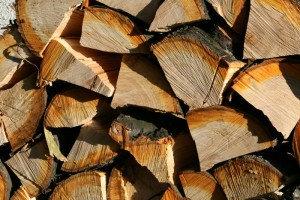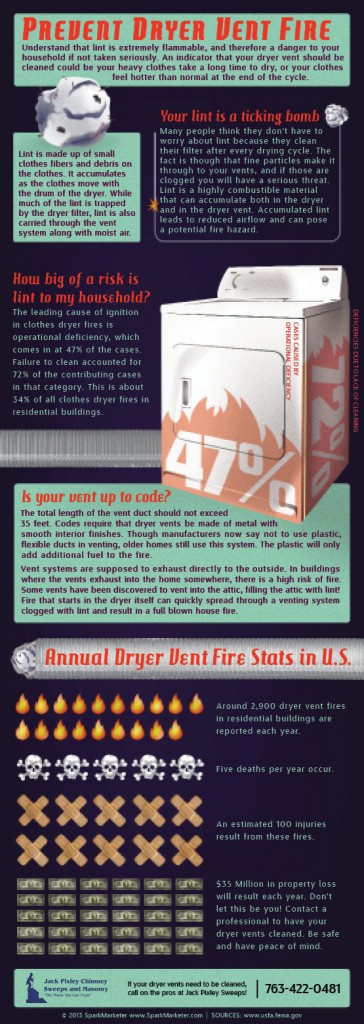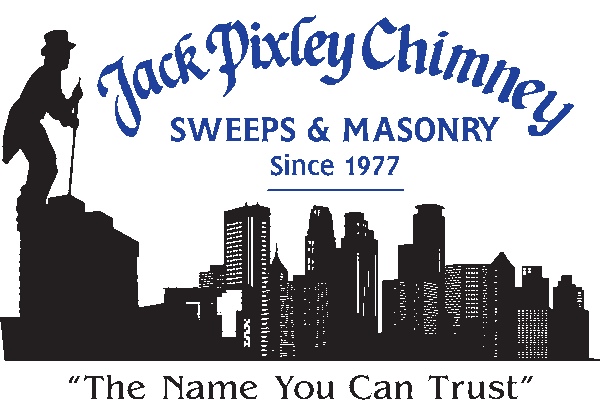
Proper storage of firewood can lead to better fires
While most homeowners go to great lengths to ensure that their fireplaces are properly maintained and in excellent working condition, many do not put nearly as much thought into what they’re putting into their fireplaces each season. Using the correct type of firewood – as well as wood that has been correctly seasoned and stored – can greatly improve fireplace performance and ensure that your fireplace system works well for years to come.
Firewood types
Although firewood is a generic term, each wood species has its own unique set of burning characteristics. Different species burn at different temperatures, speeds, and create varying amounts of smoke. Because of this, it is important to do research before investing in a large amount of firewood for the fall and winter.
The most popular and commonly used woods are often hardwoods. Hardwoods include species such as ash, maple, and oak, and can be identified by their broad leaves that typically change color during the fall. Hardwoods are generally preferred because they burn hotter and more steadily, producing less smoke than softwoods. However, hardwoods often light slowly, which can be a source of frustration when trying to build a warm, roaring fire.
Softwoods are typically needle-leafed trees such as firs, pines, and spruces. Because they produce more smoke when burned, softwoods are often a popular fuel for smoking meats. While their low burning temperature makes them somewhat less popular for fires, their ability to ignite quickly makes softwoods an ideal source for kindling. A prime example of this is using softwood kindling for a fire with hardwood logs.
Firewood seasoning
No matter what species of type of wood is being used, it is vitally important that the wood has been properly seasoned. Seasoned firewood is wood that has been chopped, stored, and exposed to the sun for at least 6 to 12 months. Doing this removes the moisture from the wood, allowing it to burn more efficiently and with less smoke. Wood that has not been properly seasoned will typically be hard to ignite and hiss while being burned due to the high water content in the wood.
Firewood that has been suitably seasoned will be lighter and less dense than freshly-cut wood, and banging two dried pieces together should produce a hollow, rather than dull, sound. Likewise, seasoned wood will often have cracked or split ends, indicating that the majority of the moisture has left the wood.
Firewood storage
While firewood should be exposed to sun and wind during the summer for seasoning, it needs to be protected from rain and snow during the winter. A cover, roof, or tarp can be used to protect a firewood pile and prevent snow from building up on the stack; however, whenever possible, the sides should remain open to allow air flow in the wood. This allows the seasoning process to continue and prevents a buildup of moisture. Likewise, wood should be stored off the ground to keep the bottom layer of wood dry, prevent rotting, and avoid insect infestation.
When bringing wood inside for use, only carry as much as you will immediately need. Firewood that is stored for long periods of time at room temperature can cause any dormant bugs in the wood to be become active.
After a winter of heavy use, most homeowners let their fireplaces fade into the background during the warm months of summer. For many, removing the remaining ashes, cleaning any stains, and wiping away soot leaves the fireplace ready for another season of use. However, fireplaces and chimneys should be swept by a professional annually to prevent any potentially hazardous buildup from becoming a far more dangerous issue down the road.
How often should my chimney be cleaned?
The CSIA, or Chimney Safety Institute of America, advises that chimneys be swept any time there is a sooty buildup in excess of 1/8th of an inch inside a flue or fireplace. As determining the amount of buildup can be difficult for the average homeowner, the CSIA recommends that they should “be inspected at least once a year for soundness, freedom from deposits, and correct clearances” by a certified chimney professional.
What time of year is recommended for a cleaning?

If it involves a chimney or fireplace, you can count on Jack Pixley Sweeps to know how to install it, repair it, clean it, and/or bring it up to code and national safety standards.
Although many homeowners wait until the weather cools off to schedule a chimney sweep appointment, it is important to have your system inspected before it is used for the first time each fall. Scheduling an appointment during the warm summer months not only guarantees that a system is in working condition when the weather begins to cool off, but also ensures that homeowners beat the fall rush and can schedule an appointment at their convenience.
Why are chimney inspections important?
Having a professional inspect and clean your chimney each year is an essential aspect of home maintenance. Unlike an average homeowner – or even a handyman – chimney sweeps are professionally trained to look for imperfections, flaws, and/or cracks that may not be visible to the untrained eye. While all systems should be inspected annually, inspections are especially important in homes that have recently had any upgrades or changes to their fireplace systems, such as converting to gas logs or the addition of a fireplace insert.
If you have recently purchased a new home, it is recommended that you have a cleaning done in the summer or fall, despite the timeline given by the previous homeowners, as this allows you to establish a relationship with a chimney sweep company, as well as informs you of the exact condition of your fireplace, flue, and chimney components. In some cases, it may be possible to work with the same company as the previous homeowners.
Scheduling an annual appointment with the same provider allows someone to become acquainted with the condition of your particular system who can then check on it over time to monitor its progress. This familiarity ensures that any changes such as cracks or blockages are quickly detected and mended, preventing the need for emergency maintenance or costly major repairs. Likewise, staying with the same provider over a period of time often means you do not have to schedule an appointment each year; traditionally, companies send out reminders to their repeat customers to let them know that they are due for an annual inspection.

Contact us to learn more about how to protect your home’s masonry
Proper chimney care is something that’s often neglected by a lot of homeowners. What they don’t realize is the importance and benefits that a properly maintained chimney can bring to your home. In our many years of experience here at Jack Pixley Sweeps, we’ve been asked more times than we can count about the effects water can have on one’s chimney. So here’s a short guide that might be really helpful.
Water is your chimney’s enemy
According to the Chimney Safety Institute of America, water damage is the number one most common cause of majority of the reported chimney damages. Direct contact with water or even minor water penetration can increase the likeliness of damaging one or several of the materials in your chimney (i.e. metal, brick, stone, cast iron etc.).
The following are examples of the damage in your chimney and home’s interior and exterior structures caused by water penetration:
- Water stains in the ceiling and wall
- Rusting of the damper assemblies
- Decaying of the exterior mortar
- Cracked or damaged flue lining system
Water damage: Classified
There are three significant types of water damage that may occur in your home. Identifying which of the three is important in repairing and preventing the recurrence of the same damage.
Spalling – this type of water damage refers to the chipping, flaking or crumbling of your masonry chimney as a result of water penetration or contact. Your chimney would show flaking on the surface of the bricks and chimney crown. This is usually caused by the freeze/thaw cycle of water wherein the moisture present in the chimney area would freeze when there is a significant drop in temperature, and would begin to thaw again once temperature starts to go up.
Rust or Corrosion – this usually affects the metal parts and materials used for your chimney (such as the chimney flashing and cap). This is the first thing that chimney experts look for during an inspection because this is one of the most common water damage out there.
Mortar Joint Damage – this part of your chimney is highly susceptible to cracking. Because of this, it is also one of the common places to absorb moisture. Moisture content with the ideal environmental conditions can be a breeding ground for molds which would pose a health risk to you and your family.
What are you still waiting for? Now that you know the damages that water may cause, you should give Jack Pixley Sweeps a call and have your home and chimney checked before it’s too late.
When you hear people talking about their fireplaces, you always seem to hear about the wood-burning types, but sometimes people want something less labor-intensive. You may hear about gas logs and fireplaces. This leaves you wondering what they are and how they differ from a standard fireplace. The people of Jack Pixley Chimney know all about the ways to install and care for a gas fireplace, so here are some advantages to help you decide if it is the route for you!
Safety

One of the biggest advantages of switching to gas, is the ease of use.
There are many ways that gas fireplaces are safer than the alternatives. First there are no sparks, which means there will not only be less cleaning to do, but also less of a chance of getting hit by a spark. This is extremely good for a house with pets and children. There are also no fumes or particle being released from wood, so there are no creosotes either. This means there is less of a chance of Carbon Monoxide poisoning. Lastly, these have no chimneys so you do not have to worry about the unfortunate chimney fires.
Ease of Use
If you are looking for a fireplace that is easy to use, is less expensive, and still heats your home, this is the way to go. First, the cost of installing the unit is much cheaper than a wood-burning fireplace, and they come in a variety of options to keep your home looking at its best. These units will always have a constant and steady heat supply. Also, you will never have to go chop firewood, or worry about reloading it as the fire dies down. They are usually operated by a simple on and off switch, and now come with remotes to control them. They also come with a special blower that helps the warm air spread through the entire home and not just the room that the unit is.
Environmentally Friendly
These are great options for anyone who is trying to live in a green home, or in any state that has put a ban on the traditional fireplaces. They also have the potential to save you big bucks on your next electric bill. Gas is more green because it produces an even heat.
Do you have any additional questions about the advantages of gas? We’d be happy to answer. Call us today.
It’s very important to keep up with dryer vent cleaning, as the built up lint is a fire hazard that endangers your house and everyone in it. Call Jack Pixley Sweeps to schedule an inspection and cleaning of your dryer vents to help you maintain a safer and more efficient dryer.

If you have any questions or would like to schedule an appointment, please give us a call! We look forward to providing you with a lifetime of high-quality, professional services!





